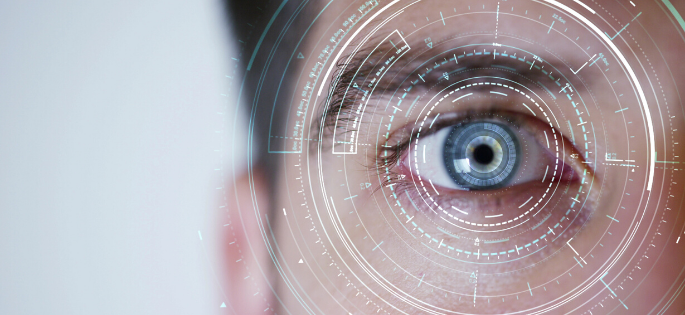Share this
Computer vision: today and tomorrow
by Clemens Niekler on Nov 15, 2019 8:47:00 AM

During our last Hackathon, we experimented with Google Cloud Vision API and its possibilities. It turned out that it is already possible to detect certain ingredients on the pizza and classify them by simply analysing pictures. Of course, this is not the only way this technology can be used. Google Vision AI and computer vision, in general, allow for many new application areas and will most probably change the way we will see the world in the future.
What is computer vision?
Computer vision aims for computers to understand the information given by visuals like photographs or videos. As this skill is essential even for children, it sounds like it should be easy to teach it to a computer as well. Nevertheless, many difficulties arise.
The visual world is not only black and white, nor it contains only 0’s and 1’s. It is much more diverse. Pictures are taken from all kinds of angles, under different lighting conditions, with (partially) hidden objects. Only artificial intelligence and in particular, Machine Learning can teach and train the computer on the millions of different images.
Use cases of computer vision
Photo categorisation
Computer Vision tools like Google’s Vision API and AutoML Vision are already being used in big corporations like The New York Times. The vast amount of pictures of The Times’ photo archive is stored in a room close to the Times Square in New York City called “The morgue”. All of these pictures that represent more than 100 years of recent history were digitised with Google Cloud’s technology. After doing so, Google’s Vision API and AutoML Vision were used to categorise the photos and make them easily accessible.
Environmental changes tracking
Furthermore, Google’s AutoML Vision is already used to protect the environment. The Texas A&M University uses the technology to indicate the so-called Environmental Sensitivity Index (ESI). The ESI helps to protect the sea and its marine life in case of possible oil spills. The model trains itself and thus improves at the detection of changes in the coastline.
Animal identification
Another example of an already existing use case of computer vision is the protection of wildlife around the world. The Zoological Society of London (ZSL) uses AutoML Vision for their camera traps that record thousands and millions of pictures in conversation areas to collect data. Many of these pictures are taken even though there are no animals around. Going through all of these photos took months. Now it is possible to do so within days, which allows the environmentalists to focus on the protection of endangered species.
Face recognition
From more accessible storage of recent history to environmental protection, computer vision and in particular, Google’s AutoML Vision and Vision API are used already. Not to forget are everyday use cases of computer vision. For example, many smartphone users use FaceID multiple times a day to unlock their phone, utilizing computer vision.

The future of computer vision
According to research, the computer vision market will reach $24 billion by 2026, which is twice as much as in 2017. The use cases of the technology will get broader and will most probably be implemented in almost every part of our lives at some point. Computer vision models won’t only be more uncomplicated to train in the future, but they will also be able to distinguish between more details.
Healthcare
One of the most prominent use cases of the computer vision technology in the future is the healthcare sector. There are already models that can detect cancer tumours more accurately than human doctors. Diagnoses executed by machines allow the specialists to focus on human contact and spend more time with their patients.
Autonomous cars
The growing field of autonomous cars is another field where computer vision plays a vital role. In the long run, it is imaginable that the technology will allow for superintelligent AI that sees the world as well or even better than humans.
Overall, computer vision might change the way we see the world and will allow humans to focus more on important tasks at their workplace and in particular, human relations.
Want to read more?
ABOUT CRYSTALLOIDS
Crystalloids helps companies improve their customer experiences and build marketing technology. Founded in 2006 in the Netherlands, Crystalloids builds crystal-clear solutions that turn customer data into information and knowledge into wisdom. As a leading Google Cloud Partner, Crystalloids combines experience in software development, data science, and marketing making them one of a kind IT company. Using the Agile approach Crystalloids ensures that use cases show immediate value to their clients and make their job focus more on decision making and less on programming.
For more information, please visit www.crystalloids.com or like us on LinkedIn.
Share this
- April 2025 (2)
- February 2025 (2)
- January 2025 (3)
- December 2024 (1)
- November 2024 (5)
- October 2024 (2)
- September 2024 (1)
- August 2024 (1)
- July 2024 (4)
- June 2024 (2)
- May 2024 (1)
- April 2024 (4)
- March 2024 (2)
- February 2024 (2)
- January 2024 (4)
- December 2023 (1)
- November 2023 (4)
- October 2023 (4)
- September 2023 (4)
- June 2023 (2)
- May 2023 (2)
- April 2023 (1)
- March 2023 (1)
- January 2023 (4)
- December 2022 (3)
- November 2022 (5)
- October 2022 (3)
- July 2022 (1)
- May 2022 (2)
- April 2022 (2)
- March 2022 (5)
- February 2022 (3)
- January 2022 (5)
- December 2021 (5)
- November 2021 (4)
- October 2021 (2)
- September 2021 (2)
- August 2021 (3)
- July 2021 (4)
- May 2021 (2)
- April 2021 (2)
- February 2021 (2)
- January 2021 (1)
- December 2020 (1)
- October 2020 (2)
- September 2020 (1)
- August 2020 (2)
- July 2020 (2)
- June 2020 (1)
- March 2020 (2)
- February 2020 (1)
- January 2020 (1)
- December 2019 (1)
- November 2019 (3)
- October 2019 (2)
- September 2019 (3)
- August 2019 (2)
- July 2019 (3)
- June 2019 (5)
- May 2019 (2)
- April 2019 (4)
- March 2019 (2)
- February 2019 (2)
- January 2019 (4)
- December 2018 (2)
- November 2018 (1)
- October 2018 (1)
- September 2018 (2)
- August 2018 (3)
- July 2018 (3)
- May 2018 (2)
- April 2018 (4)
- March 2018 (5)
- February 2018 (2)
- January 2018 (3)
- November 2017 (2)
- October 2017 (2)



